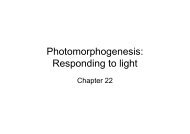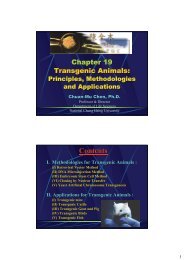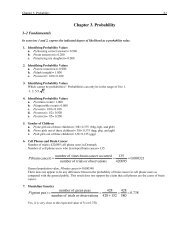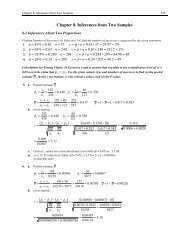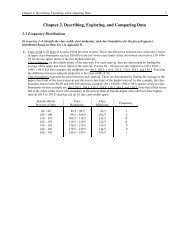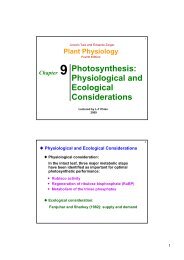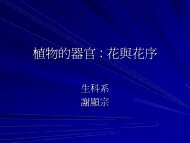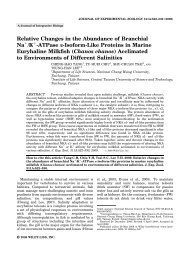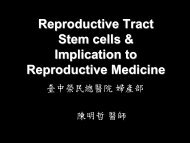Chapter 7. Hypothesis Testing with One Sample
Chapter 7. Hypothesis Testing with One Sample
Chapter 7. Hypothesis Testing with One Sample
You also want an ePaper? Increase the reach of your titles
YUMPU automatically turns print PDFs into web optimized ePapers that Google loves.
<strong>Chapter</strong> 7: <strong>Hypothesis</strong> <strong>Testing</strong> <strong>with</strong> <strong>One</strong> <strong>Sample</strong> 20324. H 0 : p = 0.103, which makes q = 0.897, n = 800, and p ˆ = 0.12. The test statistic is thenz = p ˆ − p 0.12 − 0.103= = 0.017pq 0.103⋅ 0.897 0.0107 = 1.582n 800In Exercises 25-32, use the given information to find the P-value. (Hint: See Figure 7-6.)25. It is a right tailed test, so the P-value is the area to the right of the test statistic, z = 0.55. Using the methods of5-2, the P-value is 1-0.7088 = 0.2912.26. It is a left tailed test, so the P-value is the area to the left of the test statistic,z = -1.72. Using the methods of 5-2, the P-value is 0.042<strong>7.</strong>2<strong>7.</strong> It is a two-tailed test, and the test statistic z = 1.95, is to the right of center so the p-value is the twice the areato the right of the test statistic. Using the methods of 5-2, the P-value is 2×(1–0.9744) = 0.0512.28. It is a two-tailed test, and the test statistic z = -1.63, is to the left of center so the p-value is the twice the area tothe left of the test statistic. Using the methods of 5-2, the P-value is 2×(0.0516) = 0.1032.29. Since H 1 : p > 0.29, it is a right tailed test, so the P-value is the area to the right of the test statistic, z = 1.9<strong>7.</strong>Using the methods of 5-2, the P-value is 1-0.9756 = 0.0244.30. Since H 1 : p ≠ 0.30, it is a two-tailed test, and the test statistic z = 2.44, is to the right of center so the p-value isthe twice the area to the right of the test statistic. Using the methods of 5-2, the P-value is 2×(1–0.9927) =0.0146.31. Since H 1 : p ≠ 0.31, it is a two-tailed test, and the test statistic z = 0.77, is to the right of center so the p-value isthe twice the area to the right of the test statistic. Using the methods of 5-2, the P-value is 2×(1–0.7794) =0.4412.32. Since H 1 : p < 0.32, it is a left tailed test, so the p-value is the area to the left of the test statistic, z = -1.90.Using the methods of 5-2, the P-value is 0.028<strong>7.</strong>In Exercises 33-36, state the final conclusion in simple, non-technical terms. Be sure to address the originalclaim. (Hint: See Figure 7-7)33. The original claim did not include equality, H 0 was rejected, so the conclusion is:The sample data support the claim that the proportion of men who are married is greater than 0.5.34. The original claim did not include equality, H 0 was rejected, so the conclusion is:The sample data support the claim that the proportion of college graduates who smoke is less than 0.2735. The original claim did not include equality, H 0 was not rejected, so the conclusion is:There is no sufficient sample evidence to support the claim that the proportion of fatal commercial aviationcrashes is different from 0.038.36. The original claim did include equality, H 0 was rejected, so the conclusion is:There is sufficient evidence to warrant the rejection of the claim that the proportion of M&Ms that are blue isequal to 0.10.In exercises 37-40, identify the type I error and the type II error that correspond to the given hypothesis.3<strong>7.</strong> Type I: Conclude there is sufficient evidence to support that the proportion of married women is greater than0.5 when in actuality p = 0.5Type II: Fail to reject that the proportion of married women is 0.5 when in actuality p > 0.5.




